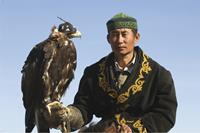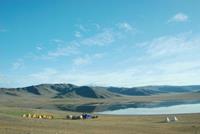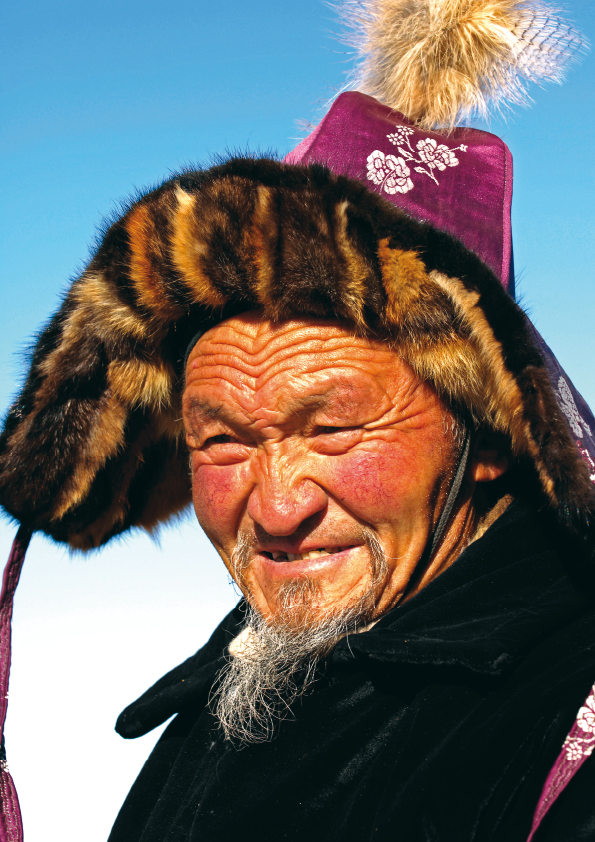Blog home / School Group Travel Destination Profile: Mongolia
Why take your school to Mongolia? If you actually need more convincing then please read on... Kazakh eagle hunter in the Altai
Kazakh eagle hunter in the Altai. The land of Nomads and no fences. I saw that line written on a Lonely Planet book once and this simple statement created an insatiable intrigue that put this amazing destination firmly in my sights. Usually a picture captures my imagination however this time it was such a simple sentence that conjured up a vivid image of an endless panorama scattered with a unique culture made of hardy people living off their wits and whatever the land provided.
Soon after, I started to do some reading. Sure, I’d heard of Genghis Khan but I hadn’t really taken any notice of who he really was and what he really achieved. Here was a man who had created the Mongol Empire into one of the largest empires the world had ever seen. His reach and influence was massive, stretching across most of Central Asia to the borders of Europe and down across modern day China. Yet when I spoke with people few ever gave him – or Mongolia – a second thought.
So it was with great excitement that I boarded the Trans Mongolian train in Beijing, which wound its way past sections of the Great Wall and outer Mongolia, for an overnight journey towards the Mongolian capital of Ulaanbaatar. It was a fascinating journey. I met my first Mongolian person, who was an artist and musician of sorts and claimed that Genghis Khan invented the internet. I took his point, he indeed had a method of sending messages great distances, but it was hardly a world wide web. Still, it gave me my first insight into how much the man was revered.
After a night’s disturbed sleep by customs officials coming into the carriage to stamp your passports, and then a short stint off the train while they changed the bogey (wheels under the carriage) I jumped out of bed to glance my first glimpse of Mongolia. I was a disappointed that the very first thing I saw was a fence! However it did only run along the train line and beyond it I could begin got put a real visual to the endless landscapes that I’d been longing to encounter.
I spent the week exploring the Gobi Desert on the back of a Bactrian camel (two humps – not one), by horse and jeep. It was nearing winter and I had the privilege of witnessing our guide utilising local GPS (ger positioning system). My stay taught me some important things. Try and travel much further afield and make sure you come in summer.
Also, make sure you know about Genghis Khan. The Mongolians have never forgotten about their national hero. His name features on everything, from the name of bars, restaurants, drinks and other assorted goods available in the State Department Stores.
So, what do you need to know if you want to plan a school group expedition?
WHEN TO GO Campsite in the Altai
Campsite in the AltaiMost definitely, only in summer. Known as "the land of blue sky", Mongolia is a remarkable sunny country enjoying 250 sunny days a year. Mongolia has warm summers and extremely cold winters. The best time to visit is May-September, although there are no guarantees that there will be good weather. In the summer, the weather can range from freezing rain and snow to temperatures above 39 C, with a possibility of fog, drizzle and torrential storms. Average temperature in most of the country is below the freezing point from November to March and close to it in April and October.
Winter nights of -40C occur most years (minimum recorded -55C). Summer extremes reach as high as +40C in the Gobi Desert and +33C in Ulaanbaatar. Monthly temperature variations of +45C to -55C are not uncommon in many regions of Mongolia.
Due to the nature of the weather when travelling you should always take along clothing that you can layer on and off.
The ideal months for active travellers really are between July and August.
ABOUT MONGOLIAMongolia is landlocked and with an average altitude of 1,580m (5,180 ft), it is one of the world’s highest countries. Between the deserts are lakes, both salt and freshwater. Lake Hovsgol holds 2% of the world’s fresh water – so fresh you can drink it.
 Traditionally dressed local
Traditionally dressed localThe nomadic lifestyle in Mongolia prevails even in the growing urban landscape around Ulaanbaatar, where gers (Yurt is a Russian word for ger) are found between the crumbling Soviet style buildings. The ger is the centrepiece of Mongolian traditions. The mobility of the tent suits the nomadic lifestyle, and the layout of the interior is culturally significant. The door always faces the south and the rear is reserved as a place of honour for guests, where a family altar is found decorated with family photos and Buddhist images.
The predominant religion of Mongolia is Buddhism, which has been revived following the lifting of the ban on religion in 1990. Historically, Mongolia has had close ties with Tibet through the Buddhist religion, and many similarities exist in the culture and lifestyle of these two countries.
Mongolian religion and their nomadic lifestyle is depicted in their music, literature and artwork. Throat (or Khoomi) singing is a particular style of male singing which requires special training, and involves several notes being released at once from the base of the throat. Contortionism is also a Mongolian tradition, and dance performances will often include a sequence.
The language is Mongolian - part of the Ural-Altaic family which also includes Finnish, Turkish, Uzbek and Korean. The language is written using the Russian Cyrillic alphabet.
PLACES / THINGS OF INTERESTGobi Desert: The Gobi Desert is an astonishing region blessed with true remoteness and rugged beauty. Due to the vast distances it is best explored via a series of day walks, jeep rides or camel treks with local nomads. Be sure to stay at a traditional 'Ger' camps with a Mongolian families, not the tourist trap setups.
 Wrestler at the Naadam Festival
Wrestler at the Naadam FestivalThe highlights of the Gobi include the ‘singing dunes’ at Khongoryn Els, named as such due to the sound they make on a windy day. However don’t expect just sand dunes in the desert. The Ikh Bogd Mountain (3957m), towers over the surrounding desert like a watchtower of the Gobi. For more ambitious groups there is the option to traverse the range and perhaps ascend the Ikh Bodh peak itself. In the southern Gobi you can view ancient petroglyphs and dinosaur excavation sites.
Naadam Festival: The colourful Naadam Festival is Mongolia’s annual celebration of all things Mongolian. The National holiday is observed right across the country and there are a series of small festivals that host horse racing, Mongolian wrestling and archery. The largest Naadam is held near Ulaanbaatar however a trip to a rural Naadam will provide a more authentic experience. Considering the rural population is largely nomadic, such a festival in a country setting is a wonderful way to see many Mongolian people converge in one large colourful gathering.
Trekking in the Altai Range: In the far west of the country is the Altai mountain range, a chain of mountains separating the nations of Russia, China, Mongolia and Kazakhstan. The key to trekking in the area is working with local knowledge, where the guide can utilise their nomadic contacts to ensure your school with an amazing and unique itinerary. The region is home to intriguing ethnic groups such as the 'Khotont' who have followed migratory routes which are wonderful routes to follow that cross spectacular passes, pass evidence of the ancient nomadic Turkic people and superb alpine landscapes boasting deep river gorges, lakes, glacier capped peaks. It is also the place to head to experience the Kazakh people who are renowned eagle hunters and trainers or the hauntingly beautiful throat-singing of the Tuvan people. This is an exhilarating journey.
Karakorum: Five hours drive out of the capital Ulaanbaatar is the deserted ancient capital of Mongolia, Karakorum. Very little remains of Karakorum, from where Genghis Khan launched his mighty cavalry however one monument that does remain is the Erdenezuu monastery. This monastery had to face the onslaught of Soviet desecration during the 19th century, but is now being slowly and lovingly restored.
Ulaanbaatar: UB, as it is fondly referred to, is an interesting city but perhaps not the highlight of a visit to Mongolia. The city has a drab Russian colour of and feels to it and one must be wary of pickpockets. Any seasoned guide will know how to avoid such riff raff. A visit to Sukhbaatar square, the central square, will inform you about the revolutionary hero of 1921, Damdiny Sukhbaatar, who declared independence from China. A short stroll will bring you to the National History Museum, dedicated to Mongolia history and culture. For a nice day trip out of the city head to the Terelj National Park where the surrounding mountains provide wonderful, gentle hiking opportunities. You can also visit the Buddhist Meditation Centre nestled in the nearby hills.
If you’ve never considered Mongolia, give it some thought. I’m sure that what you’ll learn will make you want to know more.
This article also appeared in Active Education Magazine. The author, Brad Atwal from World Expeditions Schools, is a regular contributor to Active Education Magazine.The below video was taken and made by the staff and students at Scotch College in Australia. The school travelled with World Expeditions Schools to Mongolia in 2011.[youtube http://www.youtube.com/watch?v=HxyOw7I3c4Q?rel=0]